Villa of the Mysteries
The Villa of the Mysteries (Italian: Villa dei Misteri) is a well-preserved suburban ancient Roman villa on the outskirts of Pompeii, southern Italy. It is famous for the series of exquisite frescos in one room, which are usually thought to show the initiation of a young woman into a Greco-Roman mystery cult. These are now among the best known of the relatively rare survivals of Ancient Roman painting from the 1st century BC. Like the rest of the Roman city of Pompeii, the villa was buried in the eruption of Mount Vesuvius in 79 AD and excavated from 1909 onwards (long after much of the main city). It is now a popular part of tourist visits to Pompeii, and forms part of the UNESCO World Heritage Site at Pompeii.
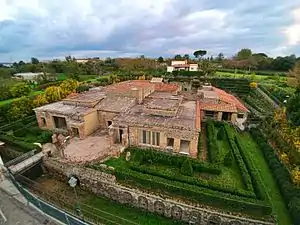

Overview
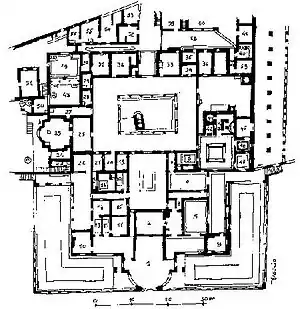
Although covered with metres of ash and other volcanic material, the Villa sustained only minor damage during the eruption of Mount Vesuvius in 79 AD. Most of its walls, ceilings, and particularly its frescoes survived largely intact. Since its excavation, the roofing and other parts of the house have been maintained as necessary.
The Villa is named for the paintings in one of its numerous rooms. This space may have been a dining room (triclinium in Latin) and is decorated with very fine frescoes, which are dated to about 70-60 BC.[1] Although the actual subject of the frescoes is debated, the most common interpretation is that they depict the initiation of a woman into the Dionysian Mysteries, a mystery cult[2] devoted to the god known to the Romans as Bacchus. Specific rites were required to become a member. A key feature that helps to identify these scenes as Bacchic is the depiction of maenads, the deity's female followers. These devotees are often shown dancing with swirling drapery on painted Greek pottery from the sixth century BC onward,[3] centuries before the cult spread to the Romans.[4] Among alternative interpretations, the most notable is that of Paul Veyne, who believes it depicts a young woman undergoing the rites of marriage.
| External video | |
|---|---|
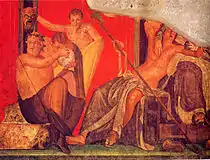 | |
Though often believed to be a triclinium, the room with the frescoes could also have been the bedroom or cubiculum of the mistress of the house, which would indicate that she was a member of the cult.[6]
In addition to fine rooms for dining and entertaining, the Villa had more functional spaces. A wine-press discovered during excavations has been restored in its original location. It was not uncommon for the homes of the very wealthy to include areas for the production of wine, olive oil, or other agricultural products, especially since many elite Romans owned farmland or orchards in the immediate vicinity of their villas.
The Villa may be easily accessed from Pompeii, lying some 400 metres northwest of the town walls, beyond a road with funerary monuments on either side. As a suburban villa, it had a close relationship with the city but was still separate from it.
The ownership of the Villa is unknown, as is the case with many private homes in the vicinity of Pompeii. However, certain artifacts give tantalizing clues. A bronze seal found in the Villa names L. Istacidius Zosimus, a freedman of the powerful Istacidii family. Scholars have proposed him either as the owner of the Villa or the overseer of its reconstruction after the earthquake of 62 AD. The presence of a statue of Livia, wife of Augustus, has led some historians to suggest that she was the owner.[7]
As in other areas of Pompeii and Herculaneum, a number of bodies were found in the Villa, and plaster casts were made of them.
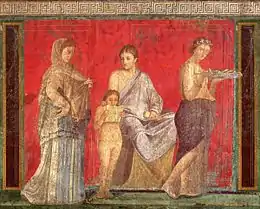
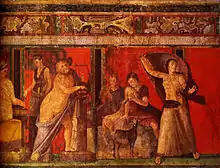
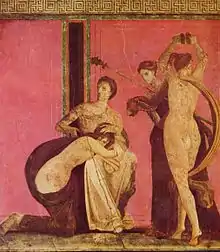
Frescoes
Restorations
The famous frescoes of the Villa were first discovered in April of 1909, but they were soon damaged by a combination of poor protection from the elements and an earthquake that occurred in June.[8] The major problems that developed were damp and salt-residues that leached from the ground, causing white stains to appear on the surface of the paintings. To counteract this, large sections of the frescoes were removed and re-attached after the walls were rebuilt with new stone to better resist the damp and salt leaching.
According to the preservation methods prevalent at the time, coatings of wax and petroleum were applied to remove the residues and provide protection, which accounts for the glossy sheen which was characteristic of the frescoes in the 20th/early 21st centuries. These coatings proved remarkably effective in protecting the paintings from further damage, even though one of the side effects was that they distorted the original coloring, making the red background appear darker than the original pigment.[8][9] Later in 1909, a German team of archaeologists arrived and undertook further restorations.
Between 2013 and 2015, restorations were undertaken on the frescoes using modern techniques. This included treatment with the antibiotic amoxicillin, which removed the manganese dioxide which had leached into the paintings from the ground, and the streptococci bacteria which feed on the pigments and cause deterioration.[9] Other treatment included the analysis and restoration of the original color tones, after laser technology was used to remove the layers of wax and petroleum applied in the early 20th century.[10][11]
Interpretation of the frescoes
There are many different interpretations of the frescoes, but they are commonly believed to depict a religious rite. Another common theory is that the frescoes depict a bride initiating into the Bacchic Mysteries in preparation for marriage. In this hypothesis, the elaborate costume worn by the main figure is believed to be wedding apparel.[6]
Based on the subject matter and order of the frescoes, they are intended to be read as a single narrative. Women and satyrs are featured prominently. Given the widely accepted theory that the murals portray an initiation into the cult of Bacchus, some propose that the frescoed room itself was used to conduct initiations and other rituals.[6]
- The first mural shows a noble Roman woman (possibly the initiate's mother, who can cross no further) approaching a priestess or matron seated on a throne, by which stands a small boy reading a scroll – presumably the declaration of the initiation. On the other side of the throne the young initiate is shown in a purple robe and myrtle crown, holding a sprig of laurel and a tray of cakes. She appears to have been transformed into a serving girl, but may be bringing an offering to the god or goddess.[12]
- The second mural depicts another priestess (or senior initiate) and her assistants preparing the liknon basket; at her feet are the legs of the bench she is sitting on that could be mistaken as mushrooms. At one side a Silenus (a creature part man and part horse) is playing a lyre. (Silenus, the name of the tutor and companion of Bacchus, was also a general term used to describe his mythological species.)[12]
- The third mural shows a satyr playing the panpipes and a nymph suckling a goat in an Arcadian scene. To their right, the initiate is in a panic. This is the last time we see her for a few scenes; when she appears again, she has changed. Some scholars think katabasis has occurred.[12]
- In the direction to which she stares in horror, the fourth mural shows a young satyr being offered a bowl of wine by Silenus, while behind him, another satyr holds up a frightening mask which the drinking satyr sees reflected in the bowl (this may parallel the mirror into which young Bacchus stares in the Orphic rites). Next to them sits a goddess, (Ariadne or Semele), with Bacchus lying across her lap.[12]
- The fifth mural shows the initiate returning. She now carries a staff and wears a cap, items often presented after the successful completion of an initiation ordeal. She kneels before the priestess, and appears to be whipped by a winged female figure. Next to her is a dancing figure (a Maenad or Thyiad) and a gowned figure with a thyrsus (an initiation symbol of Bacchus) made of long stalks of wrapped fennel, with a pine cone on top.[12]
- In the sixth mural her penultimate appearance we see her being prepared with new clothes, while Cupid holds up a mirror to her. After this scene, there is another image of Cupid.[12]
- Finally, in the seventh Mural the initiate is shown enthroned and in an elaborate costume. This is all we know of the Roman rites of initiation.[12][13][14]
Archaeology
In December 2018, archaeologists headed by Professor Massimo Osanna, director of the Pompeii archaeological site, discovered the fossilized remains of a harnessed horse with the remains of other horses. According to Mr. Osanna, the horse was probably ready to go to save people from the eruption of Mount Vesuvius.[15][16][17]
See also
- Roman architecture
- List of Roman domes
- Pompei Scavi-Villa dei Misteri railway station
References
- Giuntoli, Stefano. Art and History of Pompeii. Casa Editrice Bonechi, Florence, 1995. Page 126. ISBN 88-7009-454-5
- Antonio Virgili, Culti misterici ed orientali a Pompei, Gangemi, Roma, 2008
- Gantz, Timothy. Early Greek Myth, Volume I. The Johns Hopkins University Press, 1993. Page 114. ISBN 0-8018-5360-5
- "Villa of the Mysteries Pompeii by Raichel Le Goff". www.raichel.org. Retrieved 2015-11-19.
- "Dionysiac frieze, Villa of Mysteries, Pompeii". Smarthistory at Khan Academy. Retrieved February 20, 2013.
- "Pompeii.html". umich.edu. Retrieved 2015-11-19.
- Emily Hayes (2015-03-13). "Pompeii's Villa of the Mysteries Finally Restored After 2 Years". www.iitaly.org. Retrieved 2020-04-28.
- AA School of Architecture (2014-03-04). Mary Beard-Pompeii: The Art of Reconstruction. YouTube.com. Retrieved 2020-04-28.
- E. Bramati (2014-06-09). "The frescoes in the Villa of the Mysteries treated with antibiotics". www.arte.it. Retrieved 2020-04-28.
- Redazione ANSA (2015-03-20). "Pompeii's Villa dei Misteri reopens-Update 2". www.ansa.it. Retrieved 2020-04-28.
- Carol King (2013-07-25). "Laser Used to Restore Frescoes at Pompeii's Villa of Mysteries". Italy Magazine. Retrieved 2020-04-28.
- "Dionysian Mysteries". www.hellenica.de. Retrieved 15 November 2014.
- Linda Fierz-David, Katherine Bradway, Nor Hall, and Mary Beard and others have interpreted these murals.
- http://www.art-and-archaeology.com/timelines/rome/empire/vm/villaofthemysteries.html
- "Pompeii horse found still wearing harness". BBC News. 2018-12-24. Retrieved 2021-01-31.
- "Remains of a horse still wearing a harness found in ancient Pompeii stable". Global News. Retrieved 2021-01-31.
- White, Megan (2018-12-24). "Remains of horse found still wearing harness in ancient Pompeii stable". www.standard.co.uk. Retrieved 2021-01-31.
- Converto, Claudia. Campania, civilisation and art. Milan: Kina Italia.
External links
| Wikimedia Commons has media related to Villa of the Mysteries (Pompeii). |